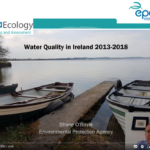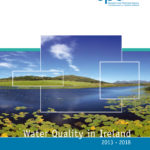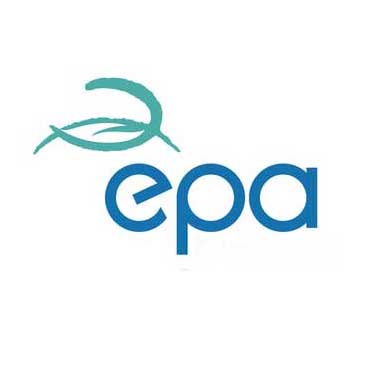The EPA report Water Quality In Ireland 2013-2018 was originally…
EPA: Water Quality in Ireland 2019-2024
The Environmental Protection Agency (EPA) published our flagship Water Quality in Ireland Report 2019-2024, which provides the latest, 3-yearly assessment of the quality of Ireland’s rivers, lakes, estuaries, coastal waters, canals and groundwaters. This assessment includes multiple water quality parameters that are monitored and assessed to give an integrated picture of the condition of our waters.
The report shows that, despite improvements in some areas, water quality in Ireland is not as good as it should be and is continuing to decline overall:
- 52 per cent of rivers, lakes, estuaries and coastal waters are in a satisfactory ecological condition, which means in good or high ecological status. This is a decline since the 2016-2021 assessment when 54 per cent of surface waters were satisfactory.
- Transitional waters, including estuaries and coastal lagoons, are in the poorest condition of any waterbody type, with 70 per cent in an unsatisfactory condition, up from 64 per cent in the last assessment.
- 92 per cent of groundwaters are in good status. Canals are also in relatively good condition with 87 per cent achieving their water quality targets.
Commenting on the report, Dr Eimear Cotter, Director of the EPA’s Office of Evidence and Assessment, said:
“Our rivers, lakes and estuaries are the lifeblood of our landscape and support our ecosystems, and our health and wellbeing. But they are struggling. They do not have the resilience to cope with the challenges they face, now and in the future. Surface water quality overall has been in decline since before the first of these assessments was carried out by the EPA in the late 2000s.
It is very disappointing to report that water quality is not improving despite the many actions that are underway, across all sectors. It’s clear the scale and pace of implementation needs to be increased and sustained.”
The main pressures impacting on water quality are excess nutrients coming mainly from agriculture, urban wastewater discharges, and damage to the physical condition of water habitats from activities such as land and river drainage, forestry and urban development.
The report highlights that there have been improvements in phosphorus levels in our surface waters in areas prioritised for action where the right measures are implemented in the right places to target interventions. There were also reductions in nitrogen levels in many river monitoring sites in recent years, which is welcome. Further reductions will be needed to reach levels that will support healthy ecosystems.
Dr Jenny Deakin, EPA Programme Manager added:
“The decreases in phosphorus levels in areas prioritised for action are very welcome. While further reductions will be needed as well as reduction in nitrate levels, this report shines a light on the progress that can be made when actions are targeted. It is essential that better information is collected by all stakeholders, on when and where the actions are being implemented on the ground, to provide better information on how the progress can be accelerated.”
Learn more:
Ecological status: The assessment of ecological status is an integrated assessment of water quality. It includes dissolved parameters in the water such as nutrients, chemicals, pH, temperature and dissolved oxygen; the species living in the water such as fish, insects, plants and algae; and the physical habitat condition of each water body. An ecological status of ‘high’ or ‘good’ is considered satisfactory; a status of ‘moderate’, ‘poor’ or ‘bad’ is unsatisfactory.
EPA water quality reporting: The EPA publishes a comprehensive assessment of Water Quality in Ireland every three years. The previous assessment was for the period 2016-2021.
The EPA also publishes water indicator data for over 1500 monitoring locations from the national water monitoring network, on an annual basis. The latest report on Nitrogen and phosphorus concentrations in Irish waters 2024 was published in July 2025.
An Early Insights Nitrogen Indicator report is also published on a 6-monthly basis. The report includes data from 20 representative monitoring stations on our largest rivers. The latest report covered the first six months of 2025 and can be accessed here.
In 2021 and 2025, the EPA published assessments of the nitrogen reductions that were needed in major catchments to support healthy aquatic ecosystems. The most recent assessment can be found here and included data up to 2024.
Water Body: A water body is an area of water, which is usually either the whole or part of a lake or coastal water, or a section of a river or an estuary (e.g. Lough Ree is one water body whereas the River Lee is divided into nine water bodies for monitoring purposes).
Nitrate: Nitrate is a form of nitrogen which is a nutrient and essential for plant growth. Too much nitrogen in a water body can lead to the over-growth of plants and algae that outcompete and displace other flora and fauna. This excessive growth can also cause oxygen depletion and damage the ecology of our water bodies. Our estuaries and coastal waters are particularly sensitive to high nitrogen concentrations. The main source of excess nitrate in the environment is agriculture. Nitrate concentrations above the Drinking Water Standard can pose a risk to human health, particularly for young children.
Phosphorus: Phosphorus is a nutrient which is essential for plant growth. As with nitrogen, too much phosphorus in a water body can lead to the over-growth of plants and algae which disturb the ecosystem. Excess phosphorus is a particular concern for the ecological health of rivers and lakes. The main sources of excess phosphorus in the environment are agriculture and urban wastewater.
Pressures impacting on waters: The EPA has published a series of reports on the main pressures impacting on waters which are available at Update on pressures impacting on water quality. Catchment level information on water quality is available here.
Water Action Plan 2024: The national Water Action Plan 2024 (also known as the River Basin Management Plan 2022-2027) sets out the national policy and actions that are being taken by all sectors to improve and protect water quality.
Chemical status: The chemical status of a water body is a measure of its pollution by hazardous chemicals. Waterbodies are classed as either Good status (not polluted), or failing to achieve Good status (one or more hazardous substance not meeting its environmental quality standard). Environmental Quality Standards are set to protect the most sensitive species from direct toxicity as well as predators and humans that may be exposed to chemical pollution.
Poly Brominated Diphenyl Ethers (PBDE) and mercury: PBDE and mercury, as measured in fish tissues, are two ubiquitous substances which are found in nearly all fish samples from waters tested in Ireland and elsewhere in Europe. They come from multiple diffuse national and international sources including the following:
- Mercury – Atmospheric deposition from burning of coal, urban runoff, industrial discharges and wastewater discharges including sludges. The concentrations of mercury in fish outlined in this report are below the food safety regulatory standards.
- PBDEs – PBDEs were historically used as flame retardants in a wide array of products. Sources in the environment include leaching from consumer products (electronics, furniture, textiles), waste management and recycling, volatilisation and atmospheric deposition, urban runoff and wastewater discharges including sludges. The use of PBDEs is currently being phased out.







